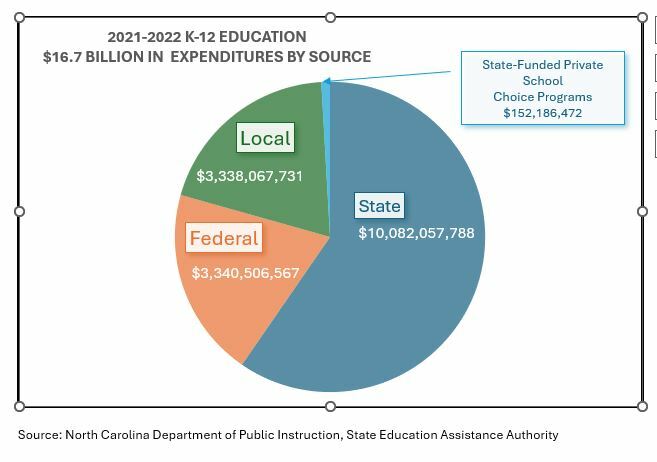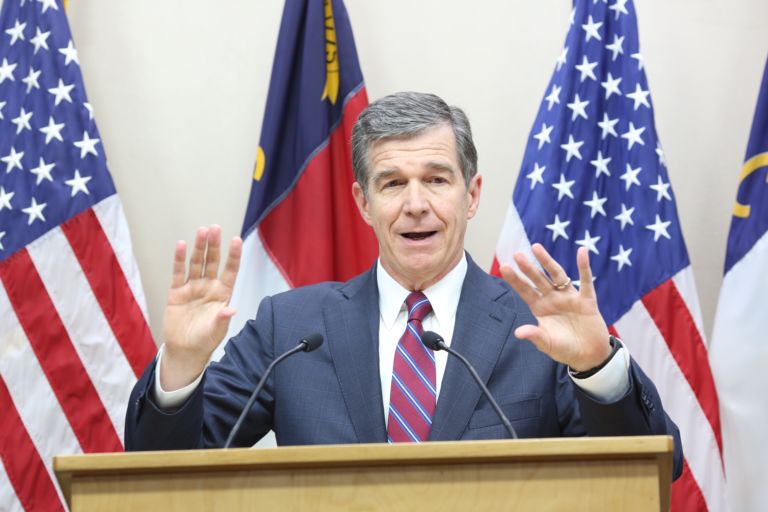Opponents of North Carolina’s Opportunity Scholarship Program claim that it damages the public schools financially. Is that claim true? Let’s take a closer look at the numbers behind this claim and recent trends in funding for private school choice programs in North Carolina.
So how much money are we talking about?
In 2021-22 (the latest year for which audited data are available), funding for the three private school choice programs in operation in North Carolina at that time (Education Student Accounts Program (ESA+), Disabilities Grant, and Opportunity Scholarship) totaled $152.1 million.
Although that is a significant number, it pales in comparison to state expenditures for K-12 education for the same year ($10.1 billion) and total expenditures, which include state, federal, and local funds ($16.7 billion).
On a percentage basis, private school choice programs comprised only about 1.5 percent of state expenditures and about 0.9 percent of all expenditures (state, federal, and local) in 2021-22.

Source: North Carolina Department of Public Instruction, North Carolina State Education Assistance Authority
But what about the trends in funding for private school choice programs?
In 2014-15, the first year of operation for the Opportunity Scholarship, $14 million was awarded in scholarships. The other private school choice program in operation at that time, the Disabilities Grant, awarded about $3 million in grants the same year. Hence, the total monies for private school choice programs in 2014-15 was about $17.2 million.
As might be expected, the smaller amounts comprised an even smaller percentage of state ($8,083,147,923) and total expenditures ($12,593,154,391): 0.2 percent and 0.13 percent, respectively, in 2014-15.
The small amount spent on private school choice programs relative to K-12 expenditures makes it difficult to accept the claim that choice programs are damaging the public schools.
Another factor that argues against this assertion is the growth in per-student revenues.
Since the voucher program began in 2015, per-student support has increased from $8,784 to $12,345. Even when we use inflation-adjusted dollars, state support has still increased almost 14 percent (13.8 percent) since 2015.
Of course, opponents of the Opportunity Scholarship Program will argue that 2022-23 represents a significant expansion of the program and that the impact of that is not really captured in the 2021-22 data. Fair enough. The reason 2021-22 is used here is because it represents the latest year for which audited expenditures are available.
Is it possible to provide a rough estimate of the financial impact? Yes. While audited expenditures are not available, state appropriations provide a general level of expenditures for K-12 education. Let’s look at the numbers.
School choice expenditures for the Opportunity Scholarship and ESA+ programs total $157,957,462. Budgeted state appropriations for K-12 education for 2022-23 are $11,278,567,752. If we use the appropriations number as a proxy for expenditures, we find that private school choice programs comprise about 1.4 percent of state expenditures in North Carolina. Although it’s an estimate, the new number does not represent significant growth in school choice spending relative to overall K-12 expenditures. Thus, even with the expected growth in private school choice programs, funding increases for the public schools have increased overall and helped to keep the size of Opportunity Scholarship expansions at a relatively small percentage of state and total expenditures.


